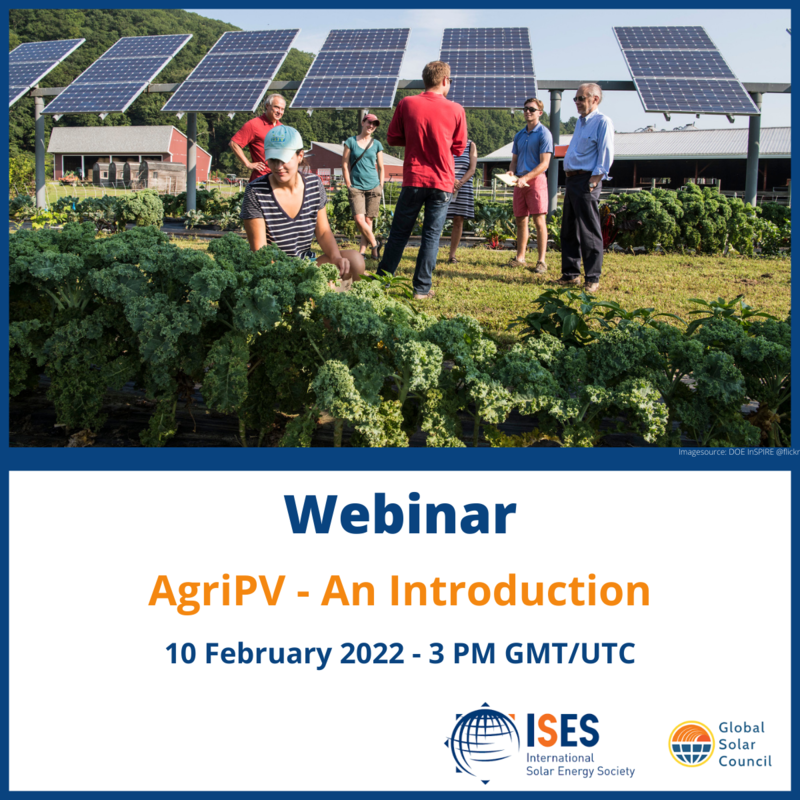Successful AgriPV Webinar by ISES and GSC
On February 10, ISES supported by the GSC welcomed 420+ attendees to the society's first webinar for 2022 - an introduction to AgriPV.
Below, please find a summary on the webinar provided by the GSC. To stay up to date on upcoming ISES webinars, visit the webinars homepage here and sign up for ISES mailings using the sign up box on the front page here.
ISES and GSC Agrivoltaics webinar draws great interest as pioneers show benefits for crops and power production
AgriPV can help address some of Society’s most pressing issues such as clean energy, water and land scarcity
Interest is rising globally around the concept of agrivoltaics, or AgriPV, the simultaneous use of land both for crop production as well as energy production using photovoltaics. AgriPV, is becoming an increasingly relevant solution for integrating food-energy synergies and tackling climate change. In a webinar organized by the International Solar Energy Society (ISES) in cooperation with the Global Solar Council, a panel of expert speakers from around the globe introduced their work on AgriPV and shared insights into trends and new developments.
Different AgriPV test-sites from across the globe were presented that demonstrate combined goals of agriculture, energy generation, community education, art and more. The webinar also showcased how the IRENA Coalition for Action Working Group on Renewables in Agriculture approaches the topic in an industry perspective.
Among the leaders in the field, Germany has developed new standards for AgriPV (German DIN SPEC 91434) defining it as the combined use of the same land area for agricultural production as the primary use and for PV electricity production as the secondary use. In Germany, the establishment of these new standards is trusted to result in an expansion of the land which is suitable for the use of AgriPV.
Thanks to the remarkable versatility of solar PV, panels and wiring can be set at tailored heights, inclinations and distances, solar trackers can help increase the power production and specific crops that benefit from lower temperature stress can be placed under the panels. The panelists emphasized during the webinar that it is possible to co-develop the same land area for both agriculture and solar PV to their mutual benefit.
A global leader in solar PV, India set forth one of the most ambitious transition plans for AgriPV. The country has one of the largest installed solar capacities in the world, and much of it comes from ground-mounted panels. With booming population growth, problems with land use constraints are mounting, emphasizing a need to identify multiple uses of scarce land resources. Another pressing issue is water availability in some regions. New AgriPV systems have been developed to allow for the water used to cleanse the panels to be collected and reused for irrigation, reducing the water footprint. Furthermore, shadows cast by the PV systems can help further reduce the water stress for specific crops. AgriPV factors in heavily when considering India’s massive 3 million solar pumps target.
Land availability is becoming an issue also in the US as solar targets rise dramatically to speed up the energy transition. New pilot projects and studies in the country highlight the opportunities arising from coupling PV with ecosystem services, like supporting pollinators and attracting beneficial insects on the cultivations, but also for water management and raising animals.
Ultimately, AgriPV has the potential to become an asset in global climate action, as case studies already show that it can ease food-energy conflicts, increase land use efficiency and create favorable microclimate conditions for plant productivity. The panelists all demonstrated how sustainable AgriPV programs can be sustained and enhanced through effective tariffs, clearer policy frameworks, better communications among stakeholders, and timely engagement with farmers.
